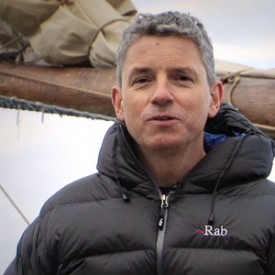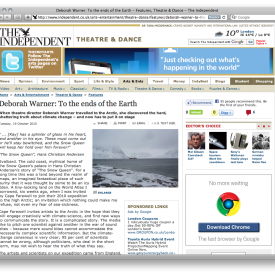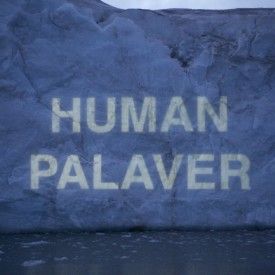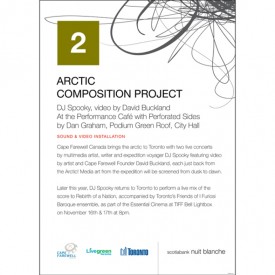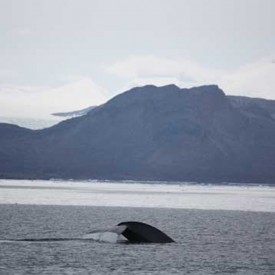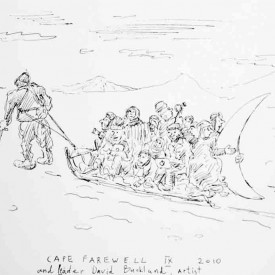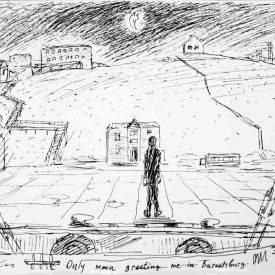 The Ends of The Earth: 9/17/2010
The Ends of The Earth: 9/17/2010
When a man journeys into a far country, he must be prepared to forget many of the things he has learned, and to acquire such customs as are inherited with existence in the new land; he must abandon the old ideals and the old gods, and ofttimes he must reverse the very codes by which his conduct has hitherto been shaped.
Jack London, In a Far Country
Today we moved through Murchison Fjord and landed in Kinnvika Bay, and explored Kinnvika Base, a group of wooden huts constructed by a collaboration of Swedish and Finnish scientists who studied the Vestfonna Glacier, one of the largest glaciers outside of Greenland in this region. The huts were built during the second International Polar Year in the late 1950’s – they reflect the form that was needed at the time – they embody the pragmatics of northern architecture: form and function flow from the desperate need that early explorers had to create structures quickly, and inexpensively. The ruins of their vehicles are rusting in front of the buildings, and I’m reminded over and over again that almost every aspect of life in this region is an uneasy tension between monuments that need to be preserved, versus the actual fact that nature in this region entombs almost everything it touches – it’s like nature itself has become a kind of abstract mausoleum. It sometimes feels like the whole situation is exploring a huge dead temple, that has a discrete life of its own. We went for a several hours walk on one of the islands to the glacier and visited the empty base that has occupied the island since the second International Polar Years back in the mid 20th century. The rusting vehicles remind me of some fragment of a JG Ballard novel or something out of Soviet Science fiction by the likes of Boris and Arkady Strugatsky and Stanislaw Lem.
As always, geography and landscape overhang almost every aspect of being here in this region, but the accumulated debris of several centuries, and the technologies and methods of exploring the landscape that each era used, these all linger in the present moment. It’s as if each island, each landscape is a collage of different eras, and with techniques like ice-core drilling, or archeology, you encounter what Heinrich Schliemann must have faced when he “discovered” the ancient city of Troy in the late 19th century. What later archeologists found was that he had dusted away all the microbes that were needed to enhance the study of the city’s material traces, plus not only had he found one city, but that the city itself was a group of cities that had been built on top of one another.
My sleep patterns haven’t been great so far: I go to bed around 2am, and get up around 6am, write for a little while, then take a nap or read for about an hour. The experience of living on a compact ship has really changed my work process, and I realize that my creativity comes from hanging out (Dj culture is all about the hang out!!!), but I really need time to withdraw and contemplate, and that means silence and working with my own material in my own time. The good thing about being with a lot of people on a ship is that you have access to the minds of the scientists, but the drawback is that there’s not enough time to absorb the situation. I tend to compose better through the “rear-view mirror” and not in “real-time.” I’ve been working on a couple more sketches based on the dreams I’ve had – the slapping of the water against the hull, the smell of the bread baking in the morning, the anchor chain rattling through the ship as we pull anchor and get ready for another day of movement. It all means that this group of “Ice Music” compositions is a kind of archeology of the everyday for me, each moment fractures into a timeline of many possibilities – time is elastic in this kind of environment. I’ve been listening to David Tudor’s “Rainforest” (a simulation of a rainforest with electronic music), Duke Ellington’s “Harlem Tone Poem,” Charles Ive’s “Central Park in the Dark” and his “Tone Roads.” That kind of thing combined with Herbert Ponting’s photographs of the Terra Nova expedition or Edward Burtansky’s photographs of the north of Canada… And it all lingers in my mind as a response to these kinds of compositions that focus on the environment (urban and natural) – it’s still unclear what it is to think of the sonic landscape of the High Arctic as a palette for new compositions. Which direction to take? Metaphor or direct musique concrete? The scientific rendition of the hexagonal structure of ice? The unique form of a snowflake? I’m still grappling with which direction to take, but so far, the sketches have been pretty solid.
I’m still thinking of the wind howling across the empty base of Kinnvika, thinking about the ice microbes preserving the history of the region in the ice, and I wonder: am I erasing the history of the place as I walk?
BACK TO TOP